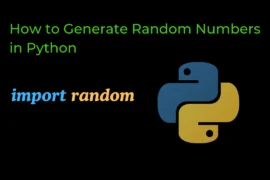In this post, we will learn about python tuples, how to create a tuple, how to access elements of a tuple, loop in a tuple, a tuple with one element, methods used in a tuple, tuple unpacking, and so on.
So let us start learning all the things one by one.
What is tuple in python?
A tuple is a built-in ordered data structure in python and it is used to store a collection of items like integer, float, string, list, dictionary, set, etc in one variable.
NOTE: Once a tuple is created you can not update or modify it because the tuple is immutable.
Why do we use tuple?
If we compare the list with tuple then yes list has much more flexibility but tuple is much faster than the list and this is the primary reason to use a tuple.
second reason sometimes we don’t need to update our data and that time tuple is the best choice to use instead of a list.
Create tuple in python
To create a tuple in python write comma-separated values inside the parenthesis (small brackets).
Example:
t1 = (1,3,5,7,'saurabh',5.3) # create a tuple
print(t1)Output:
(1, 3, 5, 7, 'saurabh', 5.3)Access elements of tuple
You can access elements of a tuple by using indexing.
Indexing starts from 0 (ZERO) and ends at len(tuple) – 1.
Example:
t1 = (1,3,5,7,'allinpython',5.3)
# access 1 ----> index value of 1 is 0
print(t1[0])
# access allinpython ---> index value of allinpython is 4
print(t1[4])
# access last elements of tuple
print(t1[-1])Output:
1
allinpython
5.3| t1 (values) | positive index values | negative index values |
| 1 | 0 | -6 |
| 3 | 1 | -5 |
| 5 | 2 | -4 |
| 7 | 3 | -3 |
| allinpython | 4 | -2 |
| 5.3 | 5 | -1 |
Loop in tuple
Iterate in a tuple using while-loop
Example:
t2 = (45,45.6,23,67,12.1)
i = 0
while i< len(t2):
print(t2[i])
i+=1Output:
45
45.6
23
67
12.1Iterate in a tuple using for-loop
t2 = ('harsh',201,21,'football')
for i in t2:
print(i)Output:
harsh
201
21
footballTuple with one element

To create a tuple with a single element put a comma after your value otherwise it is not considered a tuple element.
Example:
t3 = (2)
print(t3)
print(type(t3)) #---> return int not tuple
t3 = (2,)
print(t3)
print(type(t3)) #---> return tupleOutput:
2
<class 'int'>
(2,)
<class 'tuple'>Tuple without parenthesis
To create a tuple without using parenthesis write a comma-separated value after assigning your variable.
Example:
guitars = 'yamaha','bataon rouge','taylor'
print(guitars)
print(type(guitars))Output:
('yamaha', 'bataon rouge', 'taylor')
<class 'tuple'>Tuple unpacking
Tuple unpacking means you can store every element of a tuple in different-different variables.
Example:
# create a tuple
guitarists = ('moneti jamal', 'eddie van der meer','andrew foy')
# tuple unpacking
guitarists_1,guitarists_2, guitarists_3 = guitarists
print(guitarists_1)
print(guitarists_3)Output:
moneti jamal
andrew foyNOTE: If the number of variables is less or more than the value present inside a tuple then it will give an error.
Methods of tuple
there are only two methods used in the tuple.
- .count() method
- .index() method
.count() method
count() method counts the number of times a specified value presents in the tuple.
Example:
t2 = (45,45.6,23,67,12.1,23,45.6,23)
count1 = t2.count(23)
print(count1)
count2 = t2.count(45.6)
print(count2)Output:
3
2.index() method
index() method returns index value of specified element.
Example:
guitars = ('yamaha','bataon rouge','taylor')
index_1 = guitars.index('bataon rouge')
print(index_1)Output:
1List inside a tuple
list present inside a tuple is act like a normal list which means you can update or delete elements of the list (you can use every methods of the list like .pop(), .append(), etc.,).
Example:
t4 = (4,7,3,['rocky','yashin','malik'])
print(t4)
# access list present inside tuple
print(t4[3])
# delete last eleemnt of list
t4[3].pop()
print(t4)
# add in list
t4[3].append('roja')
print(t4)
# clear list
t4[3].clear()
print(t4)Output:
(4, 7, 3, ['rocky', 'yashin', 'malik'])
['rocky', 'yashin', 'malik']
(4, 7, 3, ['rocky', 'yashin'])
(4, 7, 3, ['rocky', 'yashin', 'roja'])
(4, 7, 3, [])Function returns two values in the form of a tuple
Example:
def func(a,b):
add1 = a+b
mul1 = a*b
return add1,mul1
print(func(3,5))
add1, mul1 = func(2,7) #tuple unpacking
print(add1)
print(mul1)Output:
(8, 15)
9
14Create a tuple with range function
Example:
nums = tuple(range(1,11))
print(nums)Output:
(1, 2, 3, 4, 5, 6, 7, 8, 9, 10)Hope this post adds some value to your life – thank you.






